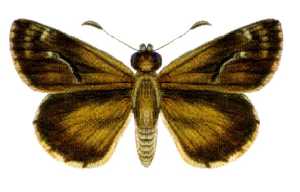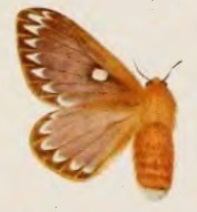
Lampides boeticus, the pea blue, or long-tailed blue, is a small butterfly that belongs to the lycaenids or gossamer-winged family.

Papilio aegeus, the orchard swallowtail butterfly or large citrus butterfly is a species of butterfly from the family Papilionidae, that is found in eastern Australia and Papua New Guinea.

Geitoneura klugii, the common xenica or Klug's xenica, is a species of butterfly belonging to the family Nymphalidae. It is a southern Australian butterfly that is easily camouflaged because of its resemblance to the ground where it is usually found fluttering. It has a wingspan of about 38 millimetres (1.5 in). The upper and lower side of the forewing is black with brownish-black markings and contains a black spot with a white centre. The orange hindwing is set off by a black border and a black-rimmed eyespot. The underside of the hindwing ranges from grey to brown and consists of darker markings.

Hippotion celerio, the vine hawk-moth or silver-striped hawk-moth, is a moth of the family Sphingidae. It was described by Carl Linnaeus in his 1758 10th edition of Systema Naturae.

Nathalis iole, the dainty sulphur or dwarf yellow, is a North American butterfly in the family Pieridae.

Abantiades latipennis, known as the Pindi moth, is a species of moth in the family Hepialidae. It may also be referred to as a swift moth or a ghost moth, as this is a common name associated with Hepialidae. Endemic to Australia and identified in 1932, it is most populous in temperate rainforest where eucalypti are prevalent, as the larvae feed primarily on the roots of these trees. Females lay eggs during flight in a scattering fashion. The larvae live for over eighteen months underground, while adult moths survive for approximately one week, as they have no mouthparts with which to feed. The moths are preyed upon by a number of predators, including bats and owls. Brown in colour overall, males are paler and the identifying silver bars of the male's wings are more prominent than those of the female's, with dark margins. Male adults are generally smaller.

Anisynta dominula, the two-brand grass-skipper or dominula skipper, is a butterfly of the family Hesperiidae. It is found in Australia in the mountains of New South Wales, Tasmania and Victoria.
Pollanisus empyrea is a moth of the family Zygaenidae. It is endemic to the temperate parts of the Australian state of Western Australia.

Dixeia pigea, the ant-heap small white or ant-heap white, is a butterfly in the family Pieridae that is native to Africa.

Pinara metaphaea, the pinara moth, is a species of moth of the family Lasiocampidae. It was first described by Francis Walker in 1862. It is known from south-east Australia, including New South Wales and Victoria.

Stictea macropetana, the eucalyptus leafroller, is a moth of the family Tortricidae. It is native to Australia, but is an introduced species in New Zealand, where it was first recorded in 1921.

Hypolycaena phorbas is a butterfly of the family Lycaenidae. It is found in Waigeo, Biak, Roon Island, mainland New Guinea and various outlying islands as well as Australia.
Myrtartona coronias is a species of moth in the family Zygaenidae. It is found in eastern and south-eastern Australia, from southern Queensland to Tasmania.

Aenetus ligniveren, the common splendid ghost moth, is a moth in the family Hepialidae. It is found from southern Queensland to Tasmania.

Aenetus dulcis is a moth of the family Hepialidae first described by Charles Swinhoe in 1892. It is known from Western Australia.
Aenetus mirabilis is a moth of the family Hepialidae. It is known from Queensland.
Aenetus ombraloma is a moth of the family Hepialidae. It is known from Tasmania.
Aenetus ramsayi, the swift ghost moth, is a moth of the family Hepialidae. It is known from Queensland and New South Wales.
Aenetus splendens is a moth of the family Hepialidae. It is known from New South Wales and Queensland.

Cotana serranotata is a moth of the family Eupterotidae. It is found in Australia, where it has been recorded from Queensland.













